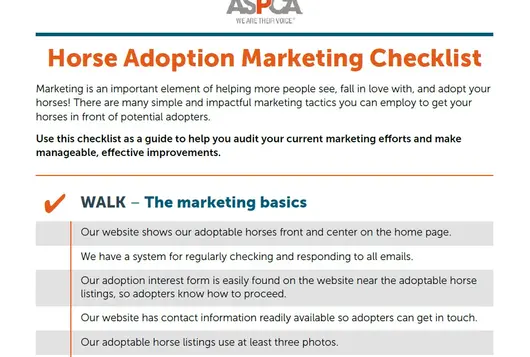Tips to Make Dog Adoptions Stick

As dog-behavior expert Patricia McConnell emphasizes in her book, Love Has No Age Limit, "If there's only one tip I could give shelters to increase the odds of a successful lifetime adoption, it would be to both have and give patience."
McConnell has more great suggestions to help you increase the chances of matches that will stand the test of time.
- Have Patience
Devote sufficient time to discuss what it's like to have a new dog in the home. Find out why potential adopters want a dog so you can help them to find that perfect match. Help align expectations with the reality of dog ownership.
This is an art form that requires diplomatic finesse: You want to be truthful but at the same time you don't want to scare the adopter away. One way to help adopters choose dogs who will fit their lifestyles is with the ASPCA's Meet Your Match™ (MYM) program.
Even though you've said the same spiel a thousand times before, stay focused and enthusiastic. For the adopter, this is a new, exciting and life-altering occasion. Some shelters train volunteers to be greeters and adoption counselors, which frees up staff time and allows outgoing and knowledgeable volunteers an opportunity to really shine.
Be patient and empathetic with new adopters if they have questions once they get their new dog home. If you don't already have an adoption follow-up plan, consider implementing the adoption follow-up procedures outlined in the ASPCA's MYM program, where staff or trained volunteers follow-up with new adopters at intervals of three days, three weeks and three months.
- Give Patience
Stress to adopters that there is an adjustment period for both them and the dog. Let them know that there may be times when they have second thoughts—after all, they've just accepted responsibility for another being. And if that being happens to be barking incessantly, jumping up on guests or peeing on the floor, McConnell says "dog adopter's remorse" may set in. Teach adopters to expect that the dog's behavior may change during this adjustment period.
Remind adopters that while they may have taken a long period of time to decide on expanding their family, their new dog has experienced a very sudden change. For example, the dog has transitioned in the space of a day from living in a shelter, where it's OK to pee on the floor, to a home where that behavior isn't acceptable.
- Keep the Faith
How does this word help give your adoptions staying power? McConnell says you can teach adopters to have faith that “this too shall pass.”
According to a 2002 study, most dogs are returned within the first six months, and 20 percent of those returns happen in the first two weeks. But just as human children outgrow their trying habits like crying, colic and the terrible twos, so will most adopted dogs.
Encourage new adopters to keep a journal of their dog's behavior. Not only will this help them to solve the problems by detecting triggers to the bad behavior, the journal will serve as an encouraging reminder of how far their dog has come.
Check out McConnell's suggestions for sharing simple tips in four key areas to ease the transition for your adopters. To learn more, listen to the recording of Patricia McConnell's webinar on Increasing the Odds of a Successful Adoption.
We have lots more on this subject:




